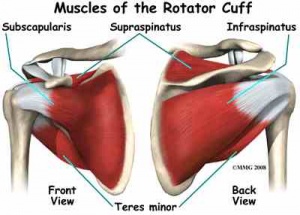Rotator Cuff: Difference between revisions
m (Text replace - 'Read more.' to ' ') |
m (Text replace - '- Your name will be added here if you are a lead editor on this page.' to ' ') |
||
| Line 2: | Line 2: | ||
'''Original Editor '''- Florence Brachotte | '''Original Editor '''- Florence Brachotte | ||
'''Lead Editors''' | '''Lead Editors''' | ||
</div> | </div> | ||
== Description == | == Description == | ||
Revision as of 16:27, 14 June 2013
Original Editor - Florence Brachotte
Lead Editors
Description[edit | edit source]
Rotator cuff is a common name for the group of 4 distinct muscles and their tendons that provide strength and stability during motion of the shoulder. The muscles arise from the scapula and connect to the head of the humerus, forming a cuff at the glenohumeral joint.
Anatomy[edit | edit source]
The rotator cuff muscles include: [1]
| Origen on scapula | Insertion on humerus | Primary function | |
|---|---|---|---|
| M. supraspinatus | supraspinous fossa | superior facet of greater tuberosity | abduction |
| M. infraspinatus | infraspinous fossa | middle facet of greater tuberosity | exorotation |
| M. teres minor | lateral border of scapula | inferior facet of greater tuberosity | exorotation |
| M. subscapularis | subscapular fossa | lesser tuberosity or humeral neck | endorotation |
Cranial to the rotator cuff, there is a bursa that covers and protects the muscle tendons as they are in close contact to the surrounding bones.
Function[edit | edit source]
The rotator cuff muscles are each used in a variety of upper extremity movements including flexion, abduction, internal rotation and external rotation. They are essential players in almost every type of shoulder movement. Balanced strength and flexibility in each of the four muscles are vital to maintain functioning of the entire shoulder girdle.
As a group, the rotator cuff muscles are responsible for stabilizing the shoulder joint. They keep the head of the humerus into the small glenoid fossa of the scapula in order to enlarge the range of motion in the glenohumeral joint and avoid mechanical obstruction.[1][2]
Common injuries to the rotator cuff[edit | edit source]
Rotator cuff injuries are common injuries that can occur at any age. In younger subjects, most injuries occur secondary to trauma or arise from overuse due to overhead activities (e.g. volleyball, tennis, pitching). Incidence of injuries increases with age, however some individuals with rotator cuff pathology may be asymptomatic.[2][3]
Most common injuries to the rotator cuff:
Diagnosis of rotator cuff pathologies[edit | edit source]
Key elements in diagnosing rotator cuff pathology are:[4]
- History
- Physical examination
- X-rays
- MRI
It is important to differentiate shoulder pain coming from places other than the shoulder, such as the neck or elbow, through anamnesis and physical examination. Pain is mostly provoked by overhead maneuvers and weakness of the shoulder muscles may occur.
Rotator cuff muscles can not be seen on X-rays but calcifications, arthritis or bone deformations - that are common causes for rotator cuff pathologies - may be visible. The most common imaging method to evaluate rotator cuff pathologies is MRI. It can detect tears and inflammation and may help to determine size and character in order to establish a proper treatment protocol.
Recent Related Research (from Pubmed)[edit | edit source]
Failed to load RSS feed from http://eutils.ncbi.nlm.nih.gov/entrez/eutils/erss.cgi?rss_guid=1D73V0aa8O8gK7mdyyrRswBQuXytpX9x2yfKuIeYjsiLMW8k_p|charset=UTF-8|short|max=10: Error parsing XML for RSS
References[edit | edit source]
see adding references tutorial.
- ↑ 1.0 1.1 Gray,H. Anatomy of the Human Body. Philadelphia: Lea &amp;amp; Febiger, 1918; Bartleby.com, 2000
- ↑ 2.0 2.1 Codman EA. The shoulder. Malibar, Florida: R.E. Kreiger; 1934
- ↑ Matsen FA 3rd. Clinical practice. Rotator-cuff failure. N Engl J Med. 2008;358: 2138-47.
- ↑ Jia X, Petersen SA, Khosravi AH, Almareddi V, Pannirselvam V, McFarland EG. Examination of the shoulder: the past, the present, and the future. J Bone Joint Surg Am. 2009;91:10-8.







